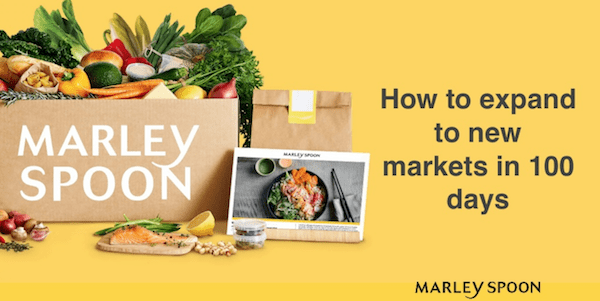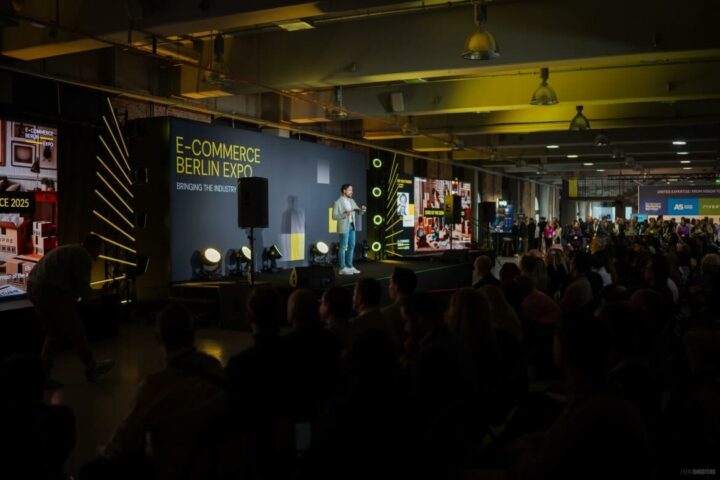EBE20 recap: How to expand to new marketing in 100 days? [Marley Spoon]
Written by
Kinga EdwardsPublished on

During the #StayHome movement, we indeed stay home and keep watching presentations from the E-commerce Berlin Expo 2020! Since we have a lot of really valuable content to go through, it takes us some time to put it all together in the form of transcripts. However, here comes the surprise! Today, we decided to take a deeper look at the presentation delivered by Dijana Dimitrovska from Marley Spoon. Dijana gave us a quick overview of how to expand to brand new markets in… 100 days.
Below, you’ll find out what Dijana shared with us during the EBE 2020. You can read our transcript or alternatively watch the presentation on YouTube. We also share it on our Slideshare if that’s what you prefer – you’ll find the link in the bottom of this article.
Dijana Dimitrowska is a Managing Director Marketing at Marley Spoon. She amazed the audience during the E-commerce Berlin Expo 2020 with her presentation about expansion. You’ll find some highlights below!

What is Marley Spoon?
Marley Spoon is the cook-at-home food delivery startup. The Berlin-based foodtech startup delivers fresh ingredients along with recipes directly to customers’ doors.
The Marley Spoon’s mission is simple:
And they felt they needed to grow. This growth need became their problem statement, and Dijana highlighted. They needed to grow… somehow.
According to Dijana, as a marketer, you either:
- invest in upper-funnel marketing
- expand to new markets
- expand your product portfolio.
Marley Spoon was also sure that the product would grow.
Citing Dijana:
“There is no way that this product doesn’t grow… everyone likes food, right?”
Thanks to their research development department, they create more than 20 different recipes every week. They keep trying to find the best recipes for various types of consumers who have a few things in common: those people like cooking, but hate the hassle, they would rather enjoy the eating part, not cooking. Thanks to Marley Spoon’s services, the “pain” of cooking is eased.
How did Marley Spoon choose where to expand?
When Dijana first looked at the map (Google Maps, to be precise!), she had eight countries in mind.
Then, she decided to filter all of her ideas out through four elements:
- Market Potential,
- Quality of Product,
- Industry & Marketing,
- Unit Economics.
Market Potential stage
Market Potential, simply put, stands behind the deep analysis, including demographics, economics, environment, society and technological analysis.
What’s interesting, the population size turned out to be not that important. For Marley Spoon, the average household size was way more important due to the nature of the product. What was also taken into account were GDP and average salary, especially average salary of household and employment rate. All these factors contributed to the selection of the countries to expand to.
Another thing taken into consideration was the Internet adoption. We live in an era when this level is very high. However it’s not the same as buying on the Internet, and it doesn’t mean that in the countries with high adoption, high spendings online follow. Marley Spoon had to research how much people actually buy online, especially when it comes to their industry – food.
According to Dijana, when thinking of expanding, you need to also look at cost of living, and the most interesting part – the grocery index, which simply means – how expensive is to buy food in supermarkets? Also, the restaurant index matters.
Market Potential stage helped Marley Spoon reduce the number of countries to expand to from 8 to 4.
Industry & Marketing stage
It could be closed in two words: competitor research and SWOT, but Dijana took it further during her presentation. She identified a few areas to cover in this stage.
Industry maturity: extensive research to find some answers about product awareness and the actual sense of expanding business there. Do people know what a meal kit is in the country we’re going to expand to? Do people care about it? Do people search for it? Do they need to be educated? What about their preferences?
Competition: it can actually be a result of your research of industry maturity. what do they do, what do they offer?
Advertising potential: What can you advertise? How cheap, or how expensive, is it to promote your products in a particular country? Checking conversion rates, cost per acquisition and the channel mix is absolutely necessary for this step.
How do tackle the promotion there? Do you need to buy know-how “somehow”, or hire someone locally, maybe make the most of influencer marketing?
Quality of Product stage
This is where two approaches come for consideration:
- product vs market – Can I launch it as it is? Should I simplify it? Are the competitors’ features better than mine?
- brand vs market – Do I need to set up another brand for a particular country? Do I need to launch more local brands?
Here’s where three of the remaining four countries dropped for Marley Spoon.
Unit Economics
Should Marley Spoon follow “bottom up” or “top-down” approach?
Bottom up means financial approach, this is the margin and profitability, how can you do with the pricing. If we feel like we have a competitive landscape, what’s the value in our product?
The country has been chosen (you’ll find it out later on!), now onto the steps of actual expansion.
Steps of actual expansion
Dijana recognized six steps:
- Convince the board that it’s a good idea to expand.
- Get the team on board – Dijana had 10 departments to convince and persuade, it’s very vital to get people on board, but in order to be successful, you also need to be very clear.
- Have a(n awesome) kick off and set up rules – as a person or team leader initiating expansion, you need to explain the thought process, keep transparency, listen to feedback and incorporate it to everyone’s goals.
- Designate sub-project leads (and colours) – to coordinate projects, with meetings set up once a week.
- Jointly devise the critical path – when you get people to task management, and when they sign on it, this is where you can have a very good commitment of what’s supposed to happen. Write and get familiar with every critical thing that has to happen to keep it all going.
- Keep up the frequency – determine the whole shape of communication, e.g. via Slack channels.
If you feel that you need a more structured and analytical approach, you can always consult a google analytics agency.
Numbers standing behind Marley Spoon expansion
- 63: people who opened a Google Spreadsheet – worked on the expansion
- 23: sheets connected to that Sheet
- 33: items on the critical path of the project
- 105: actual number of days the expansion took
- 19: number of meetings related to the expansion
- 1: one team and one goal
Where has Marley Spoon expanded?
They expanded in Denmark. They started two weeks before the launch with the lead generation campaign with three various approaches, got some press coverage.
What was the key to success, according to Dijana?
One team, one goal and processes in place.
We hope you enjoyed this “episode” of our presentations, and we promise you more to come!


